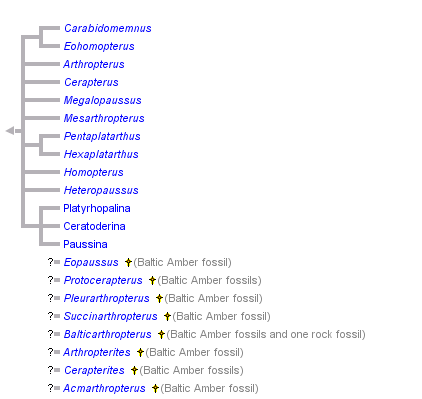Paussini



This tree diagram shows the relationships between several groups of organisms.
The root of the current tree connects the organisms featured in this tree to their containing group and the rest of the Tree of Life. The basal branching point in the tree represents the ancestor of the other groups in the tree. This ancestor diversified over time into several descendent subgroups, which are represented as internal nodes and terminal taxa to the right.

You can click on the root to travel down the Tree of Life all the way to the root of all Life, and you can click on the names of descendent subgroups to travel up the Tree of Life all the way to individual species.
For more information on ToL tree formatting, please see Interpreting the Tree or Classification. To learn more about phylogenetic trees, please visit our Phylogenetic Biology pages.
close boxReferences
Beutel, R. G. 1992. Study on the systematic position of Metriini based on characters of the larval head (Coleoptera: Carabidae). Systematic Entomology 17(3): 207-218.
Bousquet, Y. 1986. Description of first-instar larva of Metrius contractus (Coleoptera: Carabidae) with remarks about phylogenetic relationships and ranking of the genus Metrius. Canadian Entomologist 118(4): 373-388.
Bousquet, Y. and H. Goulet. 1990. Description of a new species of Metrius (Coleoptera: Carabidae: Paussini) from Idaho (USA) with comments on the taxonomic status of the other taxa of the genus. Pan Pacific Entomologist 66(1): 13-18.
Cammaerts, R., C. Detrain and M. C. Cammaerts. 1990. Host trail following by the myrmecophilous beetle Edaphopaussus favieri (Fairmaire) (Carabidae Paussinae). Insectes Sociaux 37(3): 200-211.
Carvalho, E. L. D. 1982. A previous note on the subgeneric division of the genus Paussus: 40. Contribution to a monographic study of paussids: (Insecta, Coleoptera, Carabidae). Boletim Da Sociedade Portuguesa De Entomologia 0(26): 1-9.
Eisner, T., T. H. Jones, D. J. Aneshansley, W. R. Tschinkel, R. E. Silverglied and J. Meinwald. 1977. Chemistry of defensive secretions of bombardier beetles (Brachinini, Metriini, Ozaenini, Paussini). J. Insect Physiol. 23: 1383-1386.
Evans, M. E. G. and T. G. Forsythe. 1985. Feeding mechanisms and their variation in form, of some adult ground beetles (Coleoptera: Caraboidea). Journal Of Zoology 206(1): 113-144.
Luna, D. C. E. 1987. Paussid beetles (Coleoptera, Carabidae, Paussinae) of Guinea-Bissau. Boletim Da Sociedade Portuguesa De Entomologia 0(81): 1-4.
Nagel, P. 1986. Revision of the Paussus laevifrons group (Coleoptera, Carabidae, Paussinae). Zoologische Jahrbuecher Abteilung Fuer Systematik Oekologie Und Geographie Der Tiere 113(2): 141-201.
Information on the Internet
Wendy Moore's paussine collecting pagesTitle Illustrations

| Scientific Name | Platyrhopalopsis mellyi |
|---|---|
| Location | India: Anamalai Hills |
| Specimen Condition | Dead Specimen |
| Identified By | Wendy Moore |
| Life Cycle Stage | adult |
| View | dorsal |
| Collection | Museum of Comparative Zoology |
| Image Use |
 This media file is licensed under the Creative Commons Attribution-NonCommercial-ShareAlike License - Version 3.0. This media file is licensed under the Creative Commons Attribution-NonCommercial-ShareAlike License - Version 3.0.
|
| Copyright |
© 2005 Wendy Moore

|
| Scientific Name | Falcopaussus granulatus |
|---|---|
| Location | South Africa: Pieter Maritzburg |
| Specimen Condition | Dead Specimen |
| Identified By | Wendy Moore |
| Life Cycle Stage | adult |
| View | dorsal |
| Collection | W. Moore Paussinae Collection |
| Image Use |
 This media file is licensed under the Creative Commons Attribution-NonCommercial-ShareAlike License - Version 3.0. This media file is licensed under the Creative Commons Attribution-NonCommercial-ShareAlike License - Version 3.0.
|
| Copyright |
© 2005 Wendy Moore

|
| Scientific Name | Eohomopterus aequatoriensis |
|---|---|
| Location | Ecuador: Orellana Prov., Onkone Gare Camp |
| Identified By | Wendy Moore |
| Life Cycle Stage | adult |
| View | dorsal |
| Collection | US National Museum of Natural History |
| Collector | T.L. Erwin |
| Image Use |
 This media file is licensed under the Creative Commons Attribution-NonCommercial-ShareAlike License - Version 3.0. This media file is licensed under the Creative Commons Attribution-NonCommercial-ShareAlike License - Version 3.0.
|
| Copyright |
© 2005 Wendy Moore

|
About This Page
Correspondence regarding this page should be directed to Wendy Moore at
Page copyright © 2009 Wendy Moore
 Page: Tree of Life
Paussini .
The TEXT of this page is licensed under the
Creative Commons Attribution-NonCommercial-ShareAlike License - Version 3.0. Note that images and other media
featured on this page are each governed by their own license, and they may or may not be available
for reuse. Click on an image or a media link to access the media data window, which provides the
relevant licensing information. For the general terms and conditions of ToL material reuse and
redistribution, please see the Tree of Life Copyright
Policies.
Page: Tree of Life
Paussini .
The TEXT of this page is licensed under the
Creative Commons Attribution-NonCommercial-ShareAlike License - Version 3.0. Note that images and other media
featured on this page are each governed by their own license, and they may or may not be available
for reuse. Click on an image or a media link to access the media data window, which provides the
relevant licensing information. For the general terms and conditions of ToL material reuse and
redistribution, please see the Tree of Life Copyright
Policies.
- Content changed 13 March 2009
Citing this page:
Tree of Life Web Project. 2009. Paussini . Version 13 March 2009 (temporary). http://tolweb.org/Paussini/157/2009.03.13 in The Tree of Life Web Project, http://tolweb.org/











 Go to quick links
Go to quick search
Go to navigation for this section of the ToL site
Go to detailed links for the ToL site
Go to quick links
Go to quick search
Go to navigation for this section of the ToL site
Go to detailed links for the ToL site